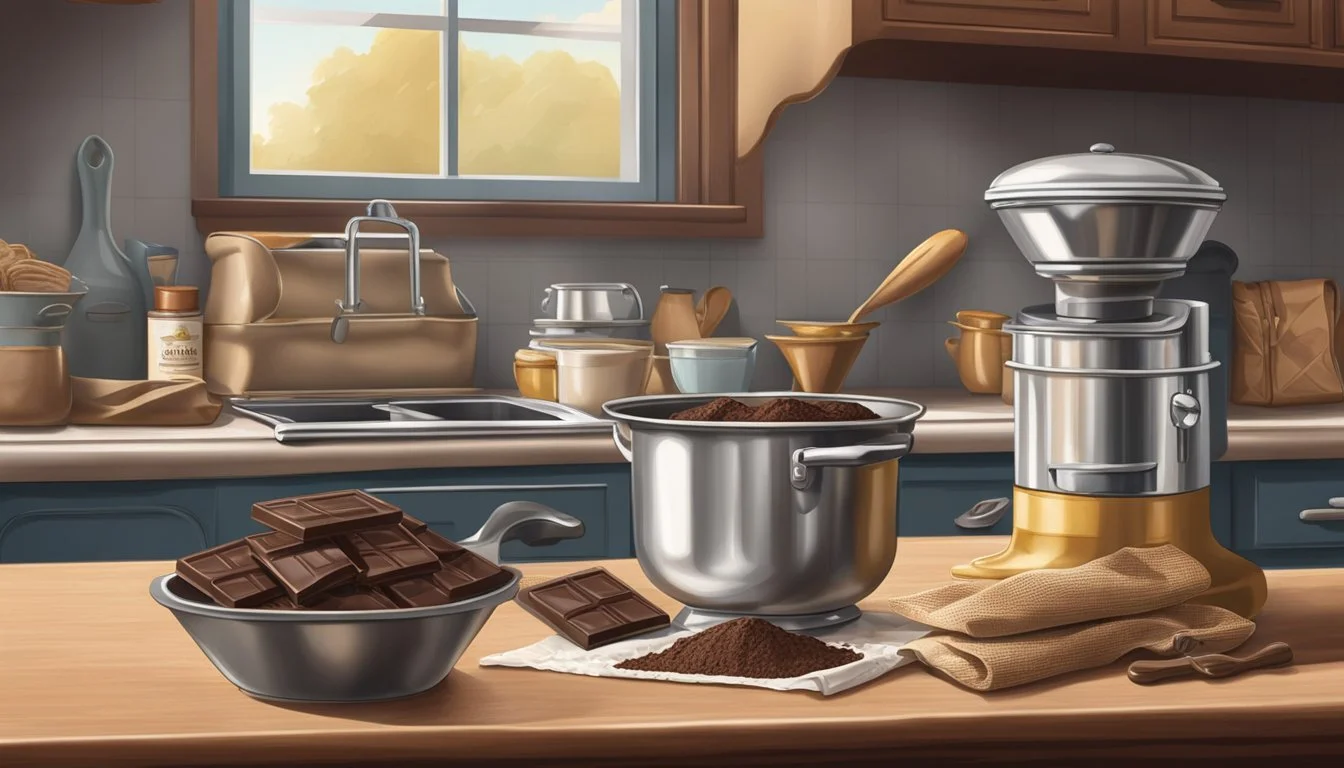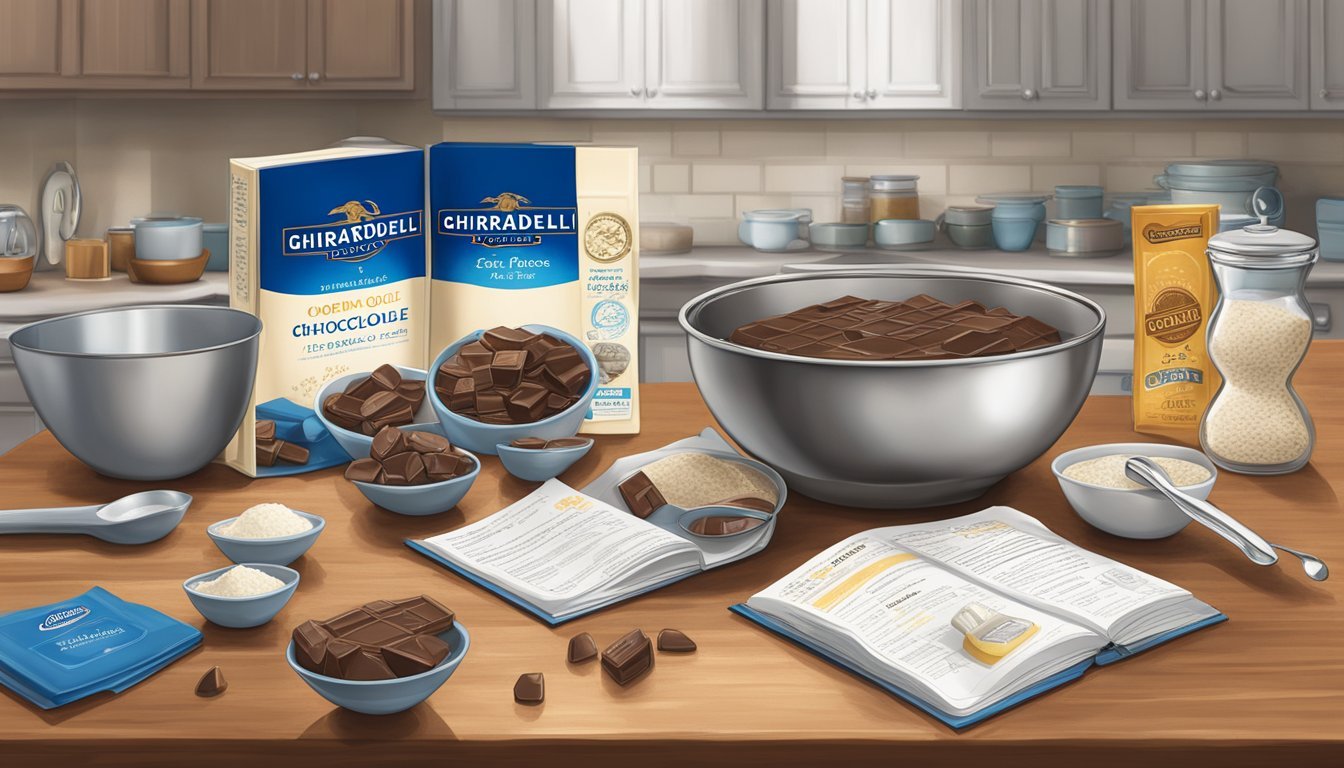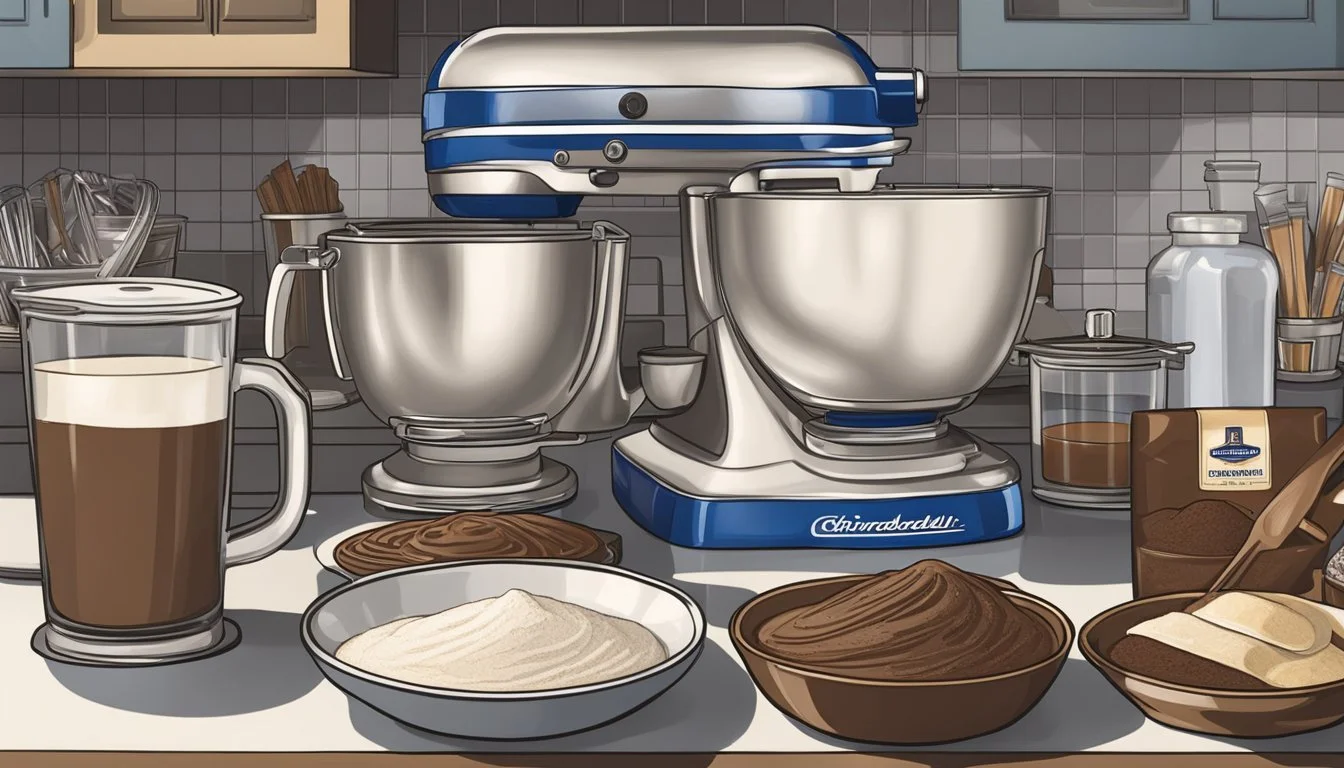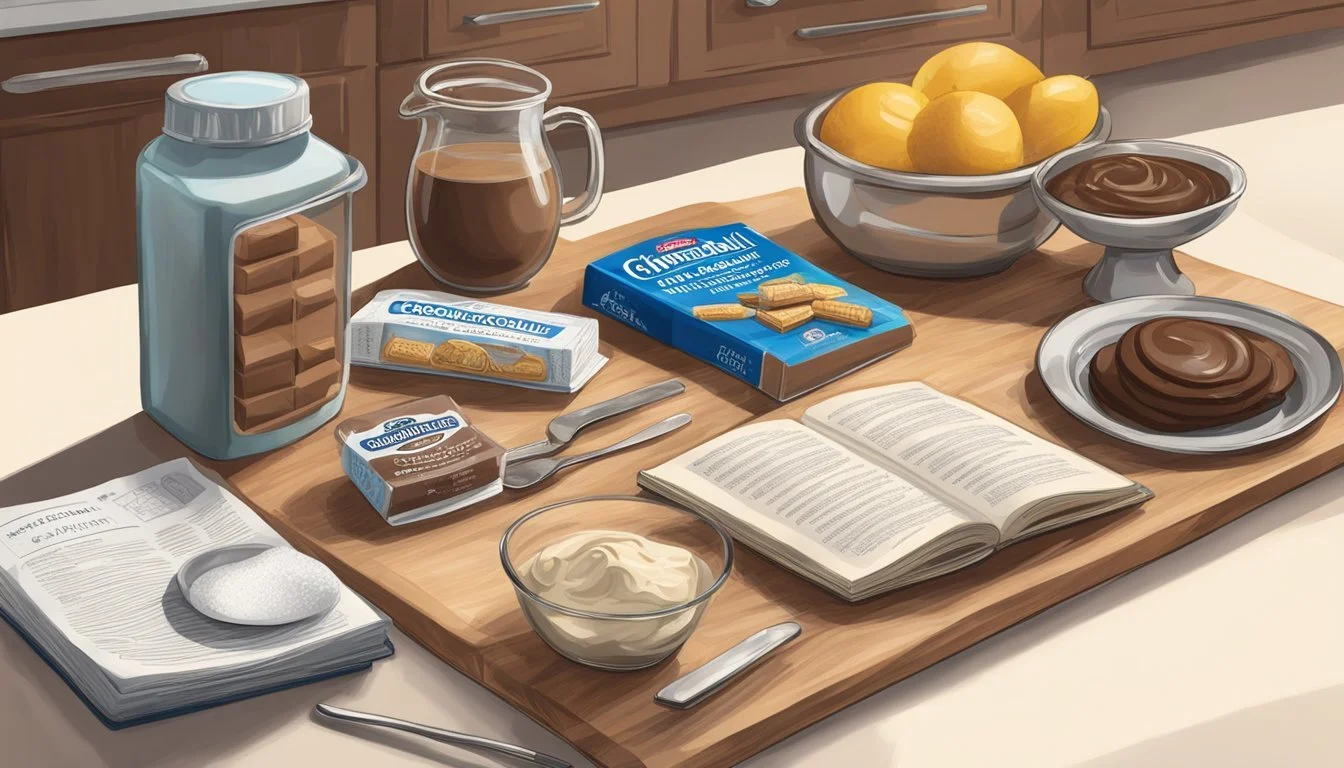How to Cook with Ghirardelli Chocolate for Baking Extravagance
Mastering Luxurious Desserts
Ghirardelli chocolate is a staple of culinary luxury and a cornerstone for countless gourmet dessert creations. It's a brand steeped in history, dating back to its founding in 1852, and has since evolved into a symbol of chocolate (What wine goes well with chocolate?) baking excellence. Understanding how to cook with Ghirardelli chocolate can transform standard baked goods into extraordinary creations due to its rich flavors and superior meltability. The versatility of Ghirardelli chocolate, ranging from Intense Dark bars to various chocolate chips, opens a world of baking extravagance, from sophisticated dark chocolate mint leaves to the classic American chocolate chip cookies.
When incorporating Ghirardelli chocolate into baking recipes, the selection of chocolate is crucial to achieving the desired flavor profile. Their range offers a variety of cacao percentage options, such as the robust 60% cacao Evening Dream, which imparts a deep, smooth chocolate essence, or the delightful Sea Salt Soirée that introduces a savory note to counterbalance sweetness. These chocolates can be melted down for glossy ganaches, chopped into chunks for decadent brownies, or even used as a sophisticated finishing touch to enhance the visual appeal and taste of desserts.
In terms of technique, bakers should take heed of the brand’s baking instructions to optimize results. Proper melting of chocolate is key—it should be done gently, avoiding high heat to prevent scorching. Whether incorporated as a solid component, like in cookies with melty chocolate pieces, or as a liquid to enrobe or drizzle, the quality of Ghirardelli ensures that baked goods made with it will be of a high standard, rich in flavor, and indulgent in nature. The brand provides an accessible way to elevate one's baking, taking it from simple to sublime with its variety of flavors and formats suited for baking applications.
History of Ghirardelli Chocolate
Ghirardelli Chocolate is a brand with deep roots in American history. It traces its origins back to the mid-19th century, when Domenico Ghirardelli, an Italian immigrant with a passion for chocolate, made his mark. Born in 1817 in Rapallo, Italy, to parents who imported exotic foods, he had chocolate in his blood from a young age, becoming an apprentice to a local candy maker.
In his twenties, Ghirardelli sailed to South America and settled in Uruguay before eventually moving to Peru. There, he established his own store. His journey led him to San Francisco during the Gold Rush in 1852, where he founded the Ghirardelli Chocolate Company.
The company experienced significant growth and became known for its innovation in chocolate-making techniques. In 1865, an accidental discovery by a Ghirardelli employee revolutionized their process. By leaving a sack of ground cacao beans in a warm environment, the cocoa butter separated, resulting in a more intense chocolate flavor upon reprocessing.
Through the years, Ghirardelli expanded its offerings:
Brownie mixes
Syrups
Ghirardelli’s commitment to quality helped solidify it as a prominent baking brand in the United States, recognized for its range of products that cater to both home bakers and professional chefs. The brand has become synonymous with luxury and indulgent chocolate experiences, all while maintaining its heritage as one of the oldest chocolate companies in America.
Understanding Chocolate Types
When cooking or baking with chocolate, especially using quality products like Ghirardelli, it's essential to understand the distinct qualities and best uses of various chocolate types. Each chocolate variant contributes a unique flavor and texture to recipes.
Dark Chocolate
Dark chocolate is rich in cocoa solids, offering a robust chocolate flavor. Ghirardelli's 72% cacao chocolate chips embody this intensity: they are ideal for recipes where a pronounced chocolate taste is desired. In dark chocolate, the higher the percentage of cocoa, the deeper the flavor.
Milk Chocolate
Milk chocolate, recognized for its creamy texture and sweet character, contains added milk which gives it a milder chocolate flavor compared to its dark counterpart. Ghirardelli milk chocolate brings a smooth and sweet touch to baked goods, perfect for a wide audience who prefer less intense chocolate notes.
White Chocolate
Technically not chocolate due to the absence of cocoa solids, white chocolate consists of cocoa butter, sugar, and milk. It offers a rich creaminess and a subtle milky flavor to confections. White chocolate from Ghirardelli can elevate mousses and frostings, adding smoothness without overpowering with chocolate taste.
Bittersweet and Semi-Sweet Chocolate
Bittersweet and semi-sweet chocolates are specific forms of dark chocolate, with semi-sweet having slightly more sugar than bittersweet. Both contain less milk than milk chocolate. These chocolates are versatile, often found in chip form, and are used in a spectrum of baking recipes from cookies to sophisticated desserts. They balance sweetness with a hint of bitterness, appealing to those who enjoy a rich, yet not overwhelming, chocolate flavor.
Essential Ingredients for Baking With Chocolate
The success of a baking endeavor using chocolate hinges on selecting premium chocolate and complementary ingredients to create a harmonious flavor and texture.
Choosing the Right Chocolate
One must select chocolate meticulously for baking. Ghirardelli offers a range of options from semi-sweet chocolate chips to unsweetened cocoa powder, each imparting unique flavor and textures suited for different recipes. Chocolate chunks yield a gooey chocolate experience in cookies, while cocoa powder is ideal for rich, dense cakes.
Butter and Fats in Baking
Quality fats, such as unsalted butter or salted butter, are crucial in baking. Unsalted butter allows for complete control over the dessert's salt content. Melted butter often leads to chewier textures, while creamed butter with sugar can introduce air, yielding a lighter concoction.
The Role of Sugars
Sugars do more than sweeten; they also contribute to texture and color. Brown sugar offers a moist, dense result with a caramel hint, while granulated sugar creates a crispier texture. A combination can balance sweetness and the textural elements within the baked good.
Leavening Agents
Leavening agents, like baking soda, interact with acidic ingredients to introduce air and lightness into chocolate baked goods. The proper ratio of baking soda to acidic components such as brown sugar or chocolate is critical in achieving the desired rise.
Flour and Dry Ingredients
The structure of baked treats is set by all-purpose flour. It binds ingredients together. For those aiming for a tender crumb, the amount and type of flour are imperative. Additionally, a pinch of salt can enhance the chocolate's depth in the overall flavor profile.
Liquids: Eggs and Vanilla
Large eggs are the binding agents in baking, contributing to structural integrity and richness. For an aromatic depth, a dash of pure vanilla extract complements the chocolate's nuanced flavors, melding with the recipe's overall taste palette.
Preparation Techniques
In the realm of Ghirardelli chocolate baking, preparation techniques are crucial for achieving the desired richness and consistency. Knowledge of proper melting, mixing, and chilling methods is essential to ensure that the chocolate's quality is preserved and its flavor is effectively showcased in the final product.
Melting Chocolate
Step 1: Chocolate should be chopped into small, even pieces to ensure uniform melting. For melting wafers, no chopping is needed as they're designed to melt easily.
Step 2: To melt chocolate, one can use a double boiler or a microwave. If using a double boiler, place two-thirds of the chocolate in the top pan and heat over hot water, not allowing water to boil, and stir constantly until the chocolate reaches a temperature of 110°-115°F before removing from heat. To cool, the chocolate should be brought down to 95°-100°F, which is ideal for tempering.
Step 3: Alternatively, microwave the chocolate at 50% power in short intervals, stirring between each, to prevent overheating.
Note: Chocolate can burn easily; monitoring the temperature is critical to avoid this.
Mixing Methods
Dry and Wet Ingredients: When preparing batter such as for brownies, one should add wet ingredients to the dry. This includes mixing eggs, oil, water, or even substituting oil with margarine, if preferred, before combining with the dry mix.
Electric Mixer: Use a spatula to fold in the chocolate for an even mix. An electric mixer should be used on a low setting to avoid over-mixing, which can affect the texture of the baked goods.
Consistency: The batter should be mixed until just combined, ensuring that pockets of dry ingredients aren't left behind.
Chilling the Dough
Timeframe: Some recipes may call for the dough to be chilled, which can help in setting the dough and making it easier to work with.
Method: The dough should be placed in a covered container and chilled in a refrigerator, typically for a minimum of 30 minutes to an hour or as the recipe requires.
Effects: Chilling dough can intensify flavors and create a firmer texture for easier handling when baking cookies or shaping truffles (What wine goes well with truffles?).
Storage: Properly wrapped dough can be refrigerated for several days, preserving its quality until ready to bake.
These preparation techniques apply across a range of Ghirardelli chocolate-based recipes and are designed to optimize the ingredient's potential. Time, temperature, and methodic stirring form the foundation for melting chocolate; a careful balance of mixing holds the key to a consistently smooth batter, and chilling the dough can transform the texture and ease of handling before baking commences.
Baking the Perfect Cookies
When crafting cookies with Ghirardelli chocolate, precision in recipe following, baking time and temperature control, as well as proper cooling and storage, are essential for optimum results.
The Classic Chocolate Chip Cookie Recipe
To create the quintessential chocolate chip cookie, one begins by preheating the oven to 375°F (190°C). The process involves combining dry ingredients such as flour, baking soda, and salt in one bowl, and in a separate bowl, creaming together butter with granulated and brown sugar. Next, eggs and vanilla extract are added into the mixture. The dry ingredients are then gradually mixed into the wet ingredients until just combined. Finally, stir in Ghirardelli chocolate chips.
Prep Time: 15 minutes
Cook Time: 9-11 minutes
Total Time: About 26 minutes
Cookie Variations
Experimentation with the basic cookie recipe can lead to delectable variations. One might introduce nuts, white chocolate chips, or dried fruit into the dough. To achieve rich flavors, consider replacing vanilla extract with almond or peppermint extract, catering to the seasonal festivities or personal preferences.
Baking Time and Temperature
The key to achieving the perfect bake lies in adhering to the recommended baking time of 9-11 minutes at 375°F (190°C). Cookies should be watched closely as they near completion to avoid over-baking, looking out for a slight golden hue along the edges and bottom.
Cooling and Storing Cookies
Once baked to perfection, cookies should be transferred to a wire rack to cool. This ensures they stop cooking and maintain their intended texture. For storage, once completely cooled, cookies can be kept in an airtight container to preserve their freshness.
By maintaining strict adherence to recipe details and realizing that even minor tweaks can yield significant changes, one ensures the baking of delicious, high-quality Ghirardelli chocolate-infused cookies every time.
Baking Other Chocolate Treats
When seeking to add indulgence to any dessert, quality chocolate is essential. Ghirardelli's baking chips and bars provide a rich foundation for a multitude of chocolate treats, from the densest brownies to the most delicate specialty desserts.
Brownies and Bars
For those who adore rich, fudgy textures, brownies made with Ghirardelli chocolate are a must-try. Incorporating semi-sweet chocolate chips or even a dark chocolate baking bar can add depth and intensity to these beloved desserts. A classic brownie recipe might call for:
1 cup Ghirardelli chocolate chips or a chopped baking bar
1/2 cup butter
1 cup sugar
2 eggs
1 teaspoon vanilla extract
3/4 cup all-purpose flour
Mixing chocolate chips into the batter not only enhances flavor but also creates pockets of melty chocolate in every bite.
Cakes and Cupcakes
Cakes and cupcakes benefit greatly from the nuanced flavors of high-quality chocolate. A simple Ghirardelli chocolate cake elevates the traditional dessert to new heights with its smooth, rich taste. For a decadent touch, one might fold in milk chocolate chips for a creamy texture or drizzle melted chocolate over the top for a glossy finish. Ingredients for a rich chocolate cake include:
1 and 3/4 cups all-purpose flour
2 cups sugar
3/4 cup Ghirardelli cocoa powder
2 teaspoons baking soda
1 teaspoon baking powder
2 large eggs
1 cup buttermilk
It's essential to use cocoa powder of the highest quality for the most robust chocolate flavor, ensuring your cakes and cupcakes stand out.
Specialty Desserts
Ghirardelli chocolate also shines in specialty desserts where chocolate is the star, such as chocolate soufflés and tarts. One can create an unforgettable chocolate tart by using a quality semi-sweet or bittersweet Ghirardelli baking bar for the filling and a chocolate chip-infused crust. The key to these desserts lies in the precision of the recipe and the excellence of the chocolate used. A chocolate tart might feature:
A chocolate crust made with finely ground cookies and Ghirardelli chocolate chips
A smooth filling crafted from melted Ghirardelli bittersweet chocolate and cream
Each dessert recipe holds the potential to become a sumptuous treat with the inclusion of Ghirardelli's premium chocolate products, promising an experience of pure baking extravagance.
Nutritional Information and Serving Sizes
When incorporating Ghirardelli Chocolate into baking, understanding the nutritional content and serving sizes is essential. Ghirardelli Chocolate Squares offer a straightforward example. For instance, every three squares, weighing 40 grams in total, contain roughly 200 calories.
Calorie Breakdown:
Fat: 51%
Carbohydrates: 45%
Protein: 4%
A baker might apply this information when calculating the nutritional value of a recipe or determining serving sizes.
In recipes featuring nuts, such as pecans or walnuts, remember that these add additional calories and nutrients. They can also implicate common allergens. In American baking culture, nuts are often revered for their ability to enhance flavor profiles and add a wholesome touch to desserts.
The inclusion of unsweetened Ghirardelli Chocolate, such as the 100% Cacao variety, is another consideration. The lack of sugar in these products often appeals to those seeking a rich cocoa flavor without the added sweetness. However, bakers should be mindful of net carbs and fiber content, especially when catering to dietary restrictions.
Serving Size Awareness:
Pay attention to net carb calculation: total carbohydrates minus fiber equals net carbs.
Acknowledge that unsweetened products can drastically differ in nutritional values compared to sweetened counterparts.
By being aware of serving sizes and the nutritional makeup of Ghirardelli Chocolate and complementary ingredients like nuts, bakers can create decadent treats that fit into a balanced diet.
Pairing and Enhancing Flavors
Mastering the art of flavor pairing and enhancement is essential when cooking with Ghirardelli chocolate. The right combinations can accentuate the chocolate's rich profile, adding a level of sophistication and depth to baked goods.
Nuts and Additional Mix-Ins
In the realm of baking, Ghirardelli chocolate pairs exceptionally well with nuts such as pecans, walnuts, and toasted almonds. These nuts not only add a satisfying crunch but also enhance the chocolate's flavor with their own rich, buttery profiles.
Pecans: Bring a caramel-like sweetness, perfect for complementing the bitterness of dark chocolate.
Walnuts: Their earthy taste can add complexity to milk chocolate's creamy sweetness.
Including nuts can elevate the texture and taste of cakes, brownies, and cookies, providing an additional layer of flavor and a contrasting crunch.
Pairing Chocolate with Fruits and Spices
Fruit and spice combinations can also elevate the taste experience of chocolate.
Berries and Black Currant: Offer bright, fruity flavors that create a delightful contrast with dense, rich chocolate.
Mint: Offers a refreshing zing that can cut through the heaviness of dark chocolate, making for a balanced and invigorating blend.
By integrating fruit elements or spice notes like cinnamon or chili, chefs can unlock a new spectrum of flavors in their chocolate-based desserts.
Flavor Complements in Chocolate Baking
Certain ingredient pairings are timeless, enhancing the chocolate flavor exponentially.
Salt: A sprinkle of sea salt can balance sweetness and intensify the overall chocolate experience.
Coffee: Introduces a roasted depth of flavor that harmonizes with chocolate for an indulgent, full-bodied taste.
Pairing chocolate with complementary flavors is key in creating a sophisticated and balanced treat that can elevate any dessert menu.
Advanced Techniques and Expert Tips
To craft a culinary masterpiece with Ghirardelli chocolate, one should employ expert techniques such as precise tempering, creating texture, and adding decorative elements. These strategies elevate a simple recipe to a professional standard by focusing on the quality of textures and finishes.
Tempering Chocolate
Tempering chocolate is a critical process to achieve a glossy finish and a satisfying snap. It involves carefully heating and cooling the chocolate to stabilize the cocoa butter crystals. One should ideally heat two-thirds of the Ghirardelli chocolate to 110-115°F, stirring constantly over a double boiler. After cooling to 95-100°F, the remaining chocolate is incorporated until fully melted. Use a reliable thermometer to ensure precision and avoid a grainy texture. For cookies, this technique can be applied to Ghirardelli Grand Chips Semi-Sweet Chocolate Chips for a lustrous effect.
Creating Texture and Layers
The secret to an indulgent texture in baked goods lies in the layering of different types of chocolate. By combining milk chocolate, semi-sweet, and bittersweet Ghirardelli chocolates, confectioners can create a nuanced flavor profile.
Texture/Layer Ghirardelli Chocolate Type Creamy Milk Chocolate Rich Bittersweet Chocolate Balanced Semi-Sweet Chocolate Chips
These contrasting layers delight the palate and add sophistication. A toothpick can be used to swirl molten chocolate into batter or frosting, creating visually appealing marbling.
Decorative Elements
Final touches with chocolate not only add charm but also textural variance. Chocolatiers might drizzle tempered chocolate over the finished goods, or use chocolate shavings for a simple yet elegant decoration. Quality ingredients like Ghirardelli chocolate ensure that these embellishments are not just aesthetically pleasing but also sumptuous in taste. When making Ghirardelli chocolate chip cookies, one could set aside a few chocolate chips to press into the top of each cookie before baking for a bakery-style finish.
Troubleshooting Common Baking Issues
When baking with Ghirardelli chocolate, bakers may encounter various issues that affect the quality of their desserts. The following are strategies to address some common baking problems related to cookies, sugar, oven, and baking techniques.
Cookies Spread Too Much:
Chill the Dough: Refrigerate for at least 30 minutes before baking to firm up fats.
Measure Accurately: Maintain the precise balance between dry and wet ingredients.
Grainy Texture from Sugar:
Dissolve Properly: Ensure sugar is completely dissolved during the creaming process with butter.
Fine Texture: Opt for superfine sugar to encourage a smoother incorporation.
Uneven Baking in Oven:
Rotate Pans: Halfway through baking, rotate your pans to ensure even heat distribution.
Oven Thermometer: Invest in an oven thermometer to guarantee accurate temperature readings.
Baking Mishaps with Chocolate:
Chocolate Burns: Melt chocolate over low heat or in short bursts in the microwave, stirring frequently.
Chocolate Seizes: Avoid any contact with water when melting chocolate; even a small amount can cause it to seize.
For optimal results, one must always preheat their oven and follow recipe specifications closely, especially when working with high-quality ingredients like Ghirardelli chocolate. By applying these troubleshooting tips, bakers can elevate their baking to a level of true extravagance.
Frequently Asked Questions
Can Ghirardelli chocolate chips be used for baking instead of bars? Yes, bakers can use Ghirardelli chocolate chips interchangeably with chocolate bars in recipes. They should ensure that the quantity used corresponds in weight to the chocolate bars their recipe requires.
What adjustments should be made when using Ghirardelli cocoa in place of unsweetened chocolate? For every ounce of unsweetened chocolate a recipe calls for, one may use 3 tablespoons of Ghirardelli Unsweetened Premium Cocoa along with an additional tablespoon of fat (butter, margarine, or vegetable shortening).
Where can one purchase Ghirardelli chocolate for baking? Ghirardelli products are widely available at various retailers, including Kroger. They can be found in the baking aisle alongside other chocolate products.
Is there a preferred method for melting Ghirardelli chocolate? Chocolate should be melted carefully to prevent burning. One can use a double boiler or microwave at half power, stirring frequently for even melting. It is also effective to melt chocolate with indirect heat in a saucepan.
Are Ghirardelli chocolate chips suitable for all types of baking? Ghirardelli chocolate chips can be used in various baking endeavors such as cookies, brownies, and cakes. They provide a rich, high-quality chocolate flavor to any dessert.
Sourcing and Sustainability of Chocolate
Ghirardelli Chocolate Company is noteworthy for its commitment to sustainability. The company has implemented a sustainable sourcing model which allows for full traceability of its cocoa beans to their origins. By tracing the beans, Ghirardelli supports the farmers and their communities by addressing specific local needs. In 2020, Ghirardelli reached its goal of sourcing 100% of its cocoa beans through a dedicated Farming Program, showcasing its dedication to both quality ingredients and ethical practices.
Sustainable chocolate, like that of Ghirardelli, often emphasizes fair trade practices. This guarantees that cocoa farmers are fairly compensated for their labor. Additionally, it fosters transparency in the supply chain, ensuring farmers receive better working conditions, fair wages, and access to essential services such as education and healthcare.
Cocoa Sourcing Highlights Description Full Traceability Ghirardelli can trace every cocoa bean back to its farm of origin, ensuring accountability and quality. Support for Farmers By sourcing beans ethically, Ghirardelli actively contributes to improving livelihoods in cocoa-farming communities. Ethical Trade Fair trade practices are central to Ghirardelli's sourcing, promoting a fair deal for farmers' labor and produce.
Choosing Ghirardelli not only adds a touch of baking extravagance but also supports a larger movement towards a sustainable and ethical chocolate industry. They ensure that consumers enjoy not just the rich flavor but also the peace of mind that comes with responsibly made chocolate.










